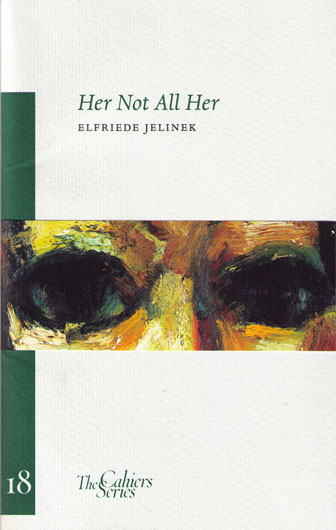
by by Margaret Kolb

Published by Sylph Editions, 2012 | 44 pages
When the prolific Austrian playwright, novelist and poet Elfriede Jelinek won the Nobel Prize in 2004 for her linguistic musicality and unsettling use of everyday language, she was not widely known outside the German-speaking world. Although she has written more than thirty plays to date, English-speaking readers are more likely to be familiar with her 1983 novel The Piano Teacher [Die Klavierspielerin], which explores an abusive mother-daughter relationship. (It was made into a film by the Austrian director Michael Haneke in 2001.) Through Damion Searl’s award-winning translation of Her Not All Her: On/With Robert Walser, however, Jelinek’s dramatic capabilities have now been made clear to English-language readers.
As its title suggests, Jelinek’s 1998 play pays homage to, engages with and speaks through the Swiss writer Robert Walser (1878-1956), whom Susan Sontag once described as “a Paul Klee in prose.” Walser was particularly known for his short stories, and the existentialism they explore. Particularly noteworthy are his microscripts, miniscule prose pieces, comprised of millimeter prose on tiny strips of paper. Jelinek’s attraction to Walser as a literary figure seems to stem from their shared status as literary outsiders. Walser never aligned himself with any particular literary movement, and though he was admired by Kafka, Benjamin and later Sebald, his works fell into obscurity after his death. Jelinek, too, has kept a certain distance from literary society. Suffering from severe social anxiety, she refused to attend her own Nobel Prize ceremony. In an interview in Frankfurter Allgemeine Zeitung, she remarked: “The moment the doors closed on me in this room, together with this crowd of people, I would drop dead.” Her pre-recorded prize speech, entitled “Sidelined,” describes the writer’s place as one that is always on the outside.
Her Not All Her can be read as a kind of dialogue between Jelinek and Walser. The German title of the play er nicht als er is partially made up of syllables taken from Robert Walser’s name (er, als, er). Jelinek provides only one stage direction: “A number of people to each other, all very friendly and well-behaved (perhaps lying in bathtubs, as once was the custom in mental hospitals).” The mental hospital setting is reminiscent of the fact that Robert Walser spent the last twenty-three years of his life as a patient at various sanatoriums. The paucity of stage directions presents significant difficulties for staging the play. Although Her Not All Her is divided into twelve long, ruminating and plotless paragraphs (plus an epilogue), it is not entirely clear how many distinct voices are present and whom these voices represent. A production by Deutsches Theater Berlin in 2012 utilized three actors. The question of whether each section is a monologue or one half of a dialogue evokes two major themes that run through Her Not All Her: the difficulties of living with, and listening to, others. The presence of others elicits fear, exhaustion and impoverishment. Her Not All Her illustrates how, in spending time together, one’s friends come to learn “all the prejudices and personal interests” one has. As a result, it becomes more and more difficult to say something of interest to this inner circle of listeners and easier to “give the impression of knowing absolutely nothing.”
In addition to the ambiguity as to who is speaking, the majority of the play is written in the second-person, which raises the further question of who the pronoun “you” even refers to. In some cases, the narrative is clearly self-referential: “Are you looking for me? You won’t find me in me.” In others, ostensibly not. Her Not All Her is also replete with exclamations and interrogations that reach beyond the boundaries of the self, demanding answers and begging for a dialogue: “Who am I? Answer, please, so that one human being can finally come into being!” Yet, at the very moment these questions are vocalized, it is apparent that speaking is not the same as being listened to. Empathy and understanding are portrayed as beyond our grasp; our perception of others as hopelessly distorted by our own projections, feelings and ideas. Walser is a fitting channel for such an analysis. As Jelinek writes, Walser was one of those writers who does “not mean themselves when they say ‘I.’”
Walter Benjamin once commented that Robert Walser’s prose mimicked his long, aimless walks, and thus reflected a certain neglect of style in which each sentence “make[s] the reader forget the previous one.” In Her Not All Her, Jelinek subscribes to a similarly ambulatory poetics, in which language is always uncertain, perspective often shifts and plot disappears. Jelinek once compared language to unruly hair that no comb could tame. Yet, what stands out about her prose in this particular work is the way in which the non-human is given feelings and agency: blossoming plants imagine with fear the hands of human beings about to touch them; rooms not only know their inhabitants but also prevent them from venturing out into the cold. Tensions between outside and inside pervade the entirety of the play. Her Not All Her ends with an epilogue about Walser’s death on Christmas Day in Herisau in 1956. He was found lying outside in a field of snow, with his hand on his heart and his hat tossed aside.
This lovely cahier by Sylph Editions contains thirteen portraits by the British artist Thomas Newbolt, taken from his series entitled Heads. These remarkable portraits rarely show the entire face, often excluding the forehead and hair and concentrating instead on the eyes, nose and lips. Newbolt painted each canvas in the dark, relying on his memory. The large eyes, painted in hues of dark blue and black, blur the iris and the pupil into solitary dark masses. The overall effect is quasi-representational and evocative of the human face, yet simultaneously highly otherworldly and expressionistic. The portraits explicitly foreground the material they are made of, as the eye attempts to discern the outlines of the human face from heaped-up edges of accumulated paint.
Jelinek asks similar questions of language: “What kind of camouflage is that, which exists, not to make one invisible, but ever more distinct?” Unveiling what it cloaks, language for Jelinek is both her protector and her enemy; while it provides shelter from the outside, it is also, as she remarked in her Nobel Prize speech, like a rabid dog snapping at her heels. In Her Not All Her, Jelinek singles out an even more striking metaphor for language: “already I’m rubbing words against each other like a cricket its wings.” Jelinek reminds us that crickets do not sing; their “song” is the product of friction, of rubbing their wings. So, too, for Jelinek, writing is a struggle to be heard.
Ayten Tartici is a PhD student in Comparative Literature at Yale University.















click to see who
MAKE Magazine Publisher MAKE Literary Productions Managing Editor Chamandeep Bains Assistant Managing Editor and Web Editor Kenneth Guay Fiction Editor Kamilah Foreman Nonfiction Editor Jessica Anne Poetry Editor Joel Craig Intercambio Poetry Editor Daniel Borzutzky Intercambio Prose Editor Brenda Lozano Latin American Art Portfolio Editor Alejandro Almanza Pereda Reviews Editor Mark Molloy Portfolio Art Editor Sarah Kramer Creative Director Joshua Hauth, Hauthwares Webmaster Johnathan Crawford Proofreader/Copy Editor Sarah Kramer Associate Fiction Editors LC Fiore, Jim Kourlas, Kerstin Schaars Contributing Editors Kyle Beachy, Steffi Drewes, Katie Geha, Kathleen Rooney Social Media Coordinator Jennifer De Poorter
MAKE Literary Productions, NFP Co-directors, Sarah Dodson and Joel Craig